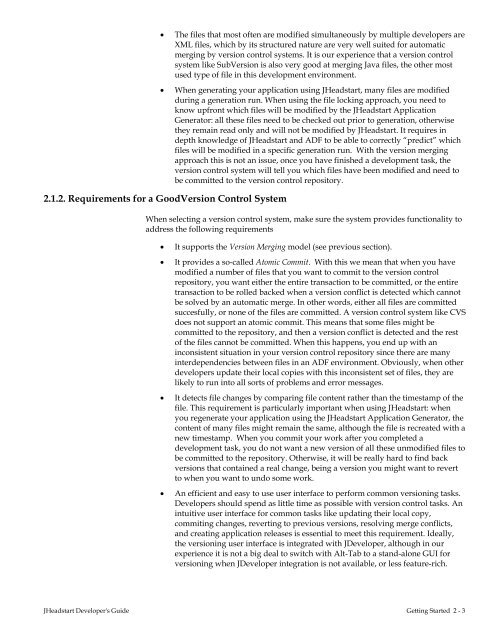Oracle JHeadstart Developer's Guide - Downloads - Oracle
Oracle JHeadstart Developer's Guide - Downloads - Oracle
Oracle JHeadstart Developer's Guide - Downloads - Oracle
You also want an ePaper? Increase the reach of your titles
YUMPU automatically turns print PDFs into web optimized ePapers that Google loves.
• The files that most often are modified simultaneously by multiple developers are<br />
XML files, which by its structured nature are very well suited for automatic<br />
merging by version control systems. It is our experience that a version control<br />
system like SubVersion is also very good at merging Java files, the other most<br />
used type of file in this development environment.<br />
• When generating your application using <strong>JHeadstart</strong>, many files are modified<br />
during a generation run. When using the file locking approach, you need to<br />
know upfront which files will be modified by the <strong>JHeadstart</strong> Application<br />
Generator: all these files need to be checked out prior to generation, otherwise<br />
they remain read only and will not be modified by <strong>JHeadstart</strong>. It requires in<br />
depth knowledge of <strong>JHeadstart</strong> and ADF to be able to correctly “predict” which<br />
files will be modified in a specific generation run. With the version merging<br />
approach this is not an issue, once you have finished a development task, the<br />
version control system will tell you which files have been modified and need to<br />
be committed to the version control repository.<br />
2.1.2. Requirements for a GoodVersion Control System<br />
When selecting a version control system, make sure the system provides functionality to<br />
address the following requirements<br />
• It supports the Version Merging model (see previous section).<br />
• It provides a so-called Atomic Commit. With this we mean that when you have<br />
modified a number of files that you want to commit to the version control<br />
repository, you want either the entire transaction to be committed, or the entire<br />
transaction to be rolled backed when a version conflict is detected which cannot<br />
be solved by an automatic merge. In other words, either all files are committed<br />
succesfully, or none of the files are committed. A version control system like CVS<br />
does not support an atomic commit. This means that some files might be<br />
committed to the repository, and then a version conflict is detected and the rest<br />
of the files cannot be committed. When this happens, you end up with an<br />
inconsistent situation in your version control repository since there are many<br />
interdependencies between files in an ADF environment. Obviously, when other<br />
developers update their local copies with this inconsistent set of files, they are<br />
likely to run into all sorts of problems and error messages.<br />
• It detects file changes by comparing file content rather than the timestamp of the<br />
file. This requirement is particularly important when using <strong>JHeadstart</strong>: when<br />
you regenerate your application using the <strong>JHeadstart</strong> Application Generator, the<br />
content of many files might remain the same, although the file is recreated with a<br />
new timestamp. When you commit your work after you completed a<br />
development task, you do not want a new version of all these unmodified files to<br />
be committed to the repository. Otherwise, it will be really hard to find back<br />
versions that contained a real change, being a version you might want to revert<br />
to when you want to undo some work.<br />
• An efficient and easy to use user interface to perform common versioning tasks.<br />
Developers should spend as little time as possible with version control tasks. An<br />
intuitive user interface for common tasks like updating their local copy,<br />
commiting changes, reverting to previous versions, resolving merge conflicts,<br />
and creating application releases is essential to meet this requirement. Ideally,<br />
the versioning user interface is integrated with JDeveloper, although in our<br />
experience it is not a big deal to switch with Alt-Tab to a stand-alone GUI for<br />
versioning when JDeveloper integration is not available, or less feature-rich.<br />
<strong>JHeadstart</strong> <strong>Developer's</strong> <strong>Guide</strong> Getting Started 2 - 3
















